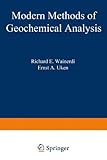Modern methods of geochemical analysis [Libro electrónico] / Edited by Richard E. Wainerdi, Ernst A. Uken
Wainerdi, Richard E [editor] | Uken, Ernst A [editor/a].
Tipo de material: Libro
en línea Series Editor: New York, New York, United States: Plenum Press, c1971Descripción: xviii, 397 páginas : ilustraciones ; 24 centímetros.ISBN: 0306304740; 9781468418323 (Print); 9781468418309 (Online).Tema(s): Analytical geochemistryNota de acceso: Disponible para usuarios de ECOSUR con su clave de acceso Nota de bibliografía: Incluye bibliografía: páginas 390-397 Número de sistema: 55481Contenidos:Mostrar
Resumen:
Libro
en línea Series Editor: New York, New York, United States: Plenum Press, c1971Descripción: xviii, 397 páginas : ilustraciones ; 24 centímetros.ISBN: 0306304740; 9781468418323 (Print); 9781468418309 (Online).Tema(s): Analytical geochemistryNota de acceso: Disponible para usuarios de ECOSUR con su clave de acceso Nota de bibliografía: Incluye bibliografía: páginas 390-397 Número de sistema: 55481Contenidos:Mostrar
Resumen:| Tipo de ítem | Biblioteca actual | Colección | Signatura | Estado | Fecha de vencimiento | Código de barras |
|---|---|---|---|---|---|---|
| Libros | Biblioteca Electrónica Recursos en línea (RE) | Acervo General | Recurso digital | ECO400554817727 |
Incluye bibliografía: páginas 390-397
1. Introduction.. 2. Statistics.. 3. Chemical analysis and sample preparation.. 4. Ion-exchange chromatography.. 5. Colorimetry.. 6. Infrared spectrophotometry.. 7. Optical emission spectroscopy.. 8. Atomic absorption.. 9. X-ray techniques.. 10. Radiometric techniques.. 11. Nuclear activation analysis.. 12. Mass spectrometry.. Index
Disponible para usuarios de ECOSUR con su clave de acceso
The founders of geology at the beginning of the last century were suspicious oflaboratories. Hutton's well-known dictum illustrates the point: "There are also superficial reasoning men . . . they judge of the great oper ations of the mineral kingdom from having kindled a fire, and looked into the bottom of a little crucible. " The idea was not unreasonable; the earth is so large and its changes are so slow and so complicated that labo ratory tests and experiments were of little help. The earth had to be studied in its own terms and geology grew up as a separate science and not as a branch of physics or chemistry. Its practitioners were, for the most part, experts in structure, stratigraphy, or paleontology, not in silicate chemistry or mechanics. The chemists broke into this closed circle before the physicists did. The problems of the classification of rocks, particularly igneous rocks, and of the nature and genesis of ores are obviously chemical and, by the mid- 19th century, chemistry was in a state where rocks could be effectively analyzed, and a classification built up depending partly on chemistry and partly on the optical study of thin specimens. Gradually the chemical study of rocks became one of the central themes of earth science. eng
Disponible en línea
Disponible en formato PDF
Subscripción a ELSEVIER 26 de diciembre del 2013
